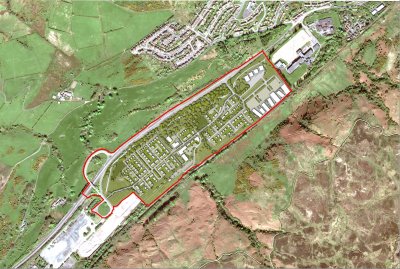Public Blog
Making brownfield work for the community
May 10th, 2020The problem with brownfield
Spango Valley in Greenock became the home of IBM manufacturing in Scotland in the 1950s, when computers were the size of a small room. Termed the ‘Silicon Glen’, at its height the plant housed thousands of workers, establishing its position as a key element of Greenock’s employment and social fabric for over 50 years, while providing a focus for the local community and an inherent civic pride.
The closure of the facility in 2016, robbed this area of more than just jobs. The factory site has lain derelict for the last four years, with development potential constrained by a need to retain this brownfield site as employment land, as well as the considerable remediation required and the flooding challenges posed by the Spango Burn, which runs through the site. The site is also located away from the town’s nearby ports, and as such doesn’t present a natural employment opportunity.
This is not an unfamiliar story across Scotland or the wider UK. At Glenrothes’ Tullis Russell Paper Mill, for example, a similarly major local manufacturer’s departure left behind a contaminated, largely derelict but nonetheless significant employment site, caught between a town centre and housing estates.
The challenge is to deliver acceptable change for these sites, so steeped in local pride and historical economic opportunity, and so important to the health – economic and social - of a community. My practice, Barton Willmore, and its designers and planners have faced these challenges across several projects, with IBM at Greenock being our most recent experience.
Restoring the heart of a community
When set the task of making brownfield sites such as these work once again for the community, understanding the constraints is always the starting point. Both examples were protected for employment use in a Local Development Plan, but no prospective plan had been able to replace the previous employment provision – often due to changes in the local market and commercial viability. The crucial stage in working through these problems and finding a new lease of life for the sites and their communities is to engage with everyone who will be impacted by the project.
At Tullis Russell in Glenrothes, this meant not just shaping the options for the landowner, but opening discussions with the local council about changing the land uses across the site. We were also engaging with the local Community Council and its aspirations for the project. What resulted was a locally-informed, commercially realistic, yet ambitious response, which reflected the community’s needs and would deliver tangible benefits.
Our proposals for IBM are at an earlier stage and we recognise the need to consider what scale of employment is now suitable and deliverable in this location. We have taken forward the lessons from our experience at Glenrothes, and our submission for a mixed-use regeneration in Greenock includes up to 450 new homes, alongside areas of new employment, leisure, community and retail, as well as a new Park and Ride facility adjacent to the existing IBM Rail Halt and station, which will re-open to the public. These proposals represent a £100m investment in the local area, and an opportunity to drive economic growth in Greenock.
Getting all the pieces in place to redevelop large brownfield sites like these may well pose a significant challenge, but it is essential to the lives and livelihoods of people across Scotland that these sites are not abandoned or neglected – that councils, communities, and developers can come together to present plans for these sites that are realistic yet ambitious, and that will deliver genuine benefits once again to the areas of which they are a part.



